Exploring Hesiod’s The Five Ages: A Deep Dive into Greek Mythology
VerifiedAdded on 2023/06/03
|8
|2039
|102
Essay
AI Summary
This essay provides an analysis of Hesiod's 'The Five Ages' from his work *Theogony*, exploring the context, themes, and interpretations of this foundational Greek myth. The essay delves into each of the five ages—Golden, Silver, Bronze, Heroic, and Iron—detailing their characteristics and the transitions between them as described by Hesiod. It also examines various perspectives on Greek myths, including ancient views, rationalizations of miraculous events, and modern scholarly theories. The analysis considers the persistence of classical mythology, its decline and revival, and different ways of interpreting myths, such as externalist and internalist theories. Furthermore, the essay touches upon the influence of Greek mythology on later generations, including poets and writers from the Victorian era, and its connection to real-life experiences. The essay concludes that the theories related to Greek mythology, particularly those in Hesiod's 'The Five Ages,' offer insights into human conditions and the evolution of humanity, highlighting both the imperfections and the values represented in these ancient narratives. Desklib provides access to this and other student-contributed assignments.
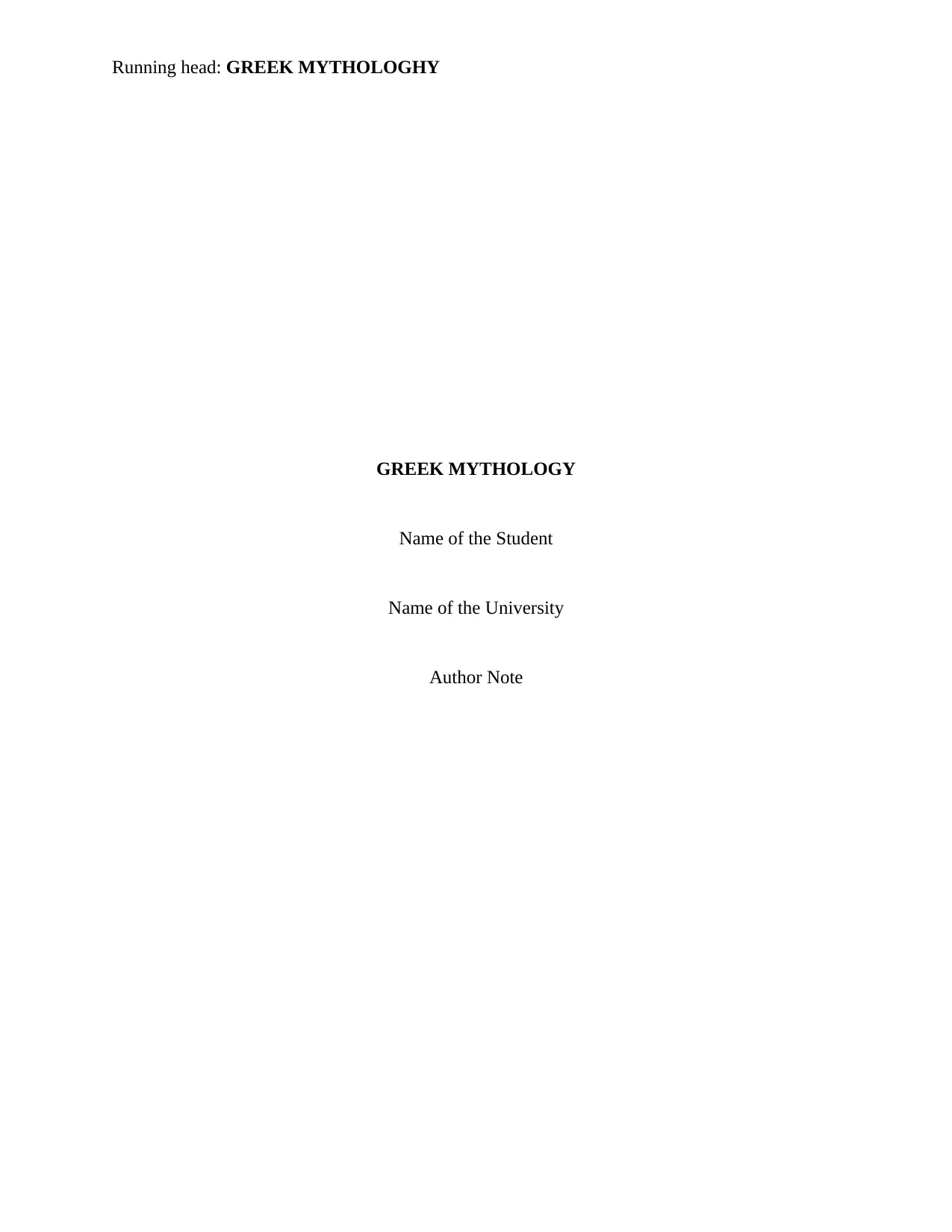
Running head: GREEK MYTHOLOGHY
GREEK MYTHOLOGY
Name of the Student
Name of the University
Author Note
GREEK MYTHOLOGY
Name of the Student
Name of the University
Author Note
Paraphrase This Document
Need a fresh take? Get an instant paraphrase of this document with our AI Paraphraser
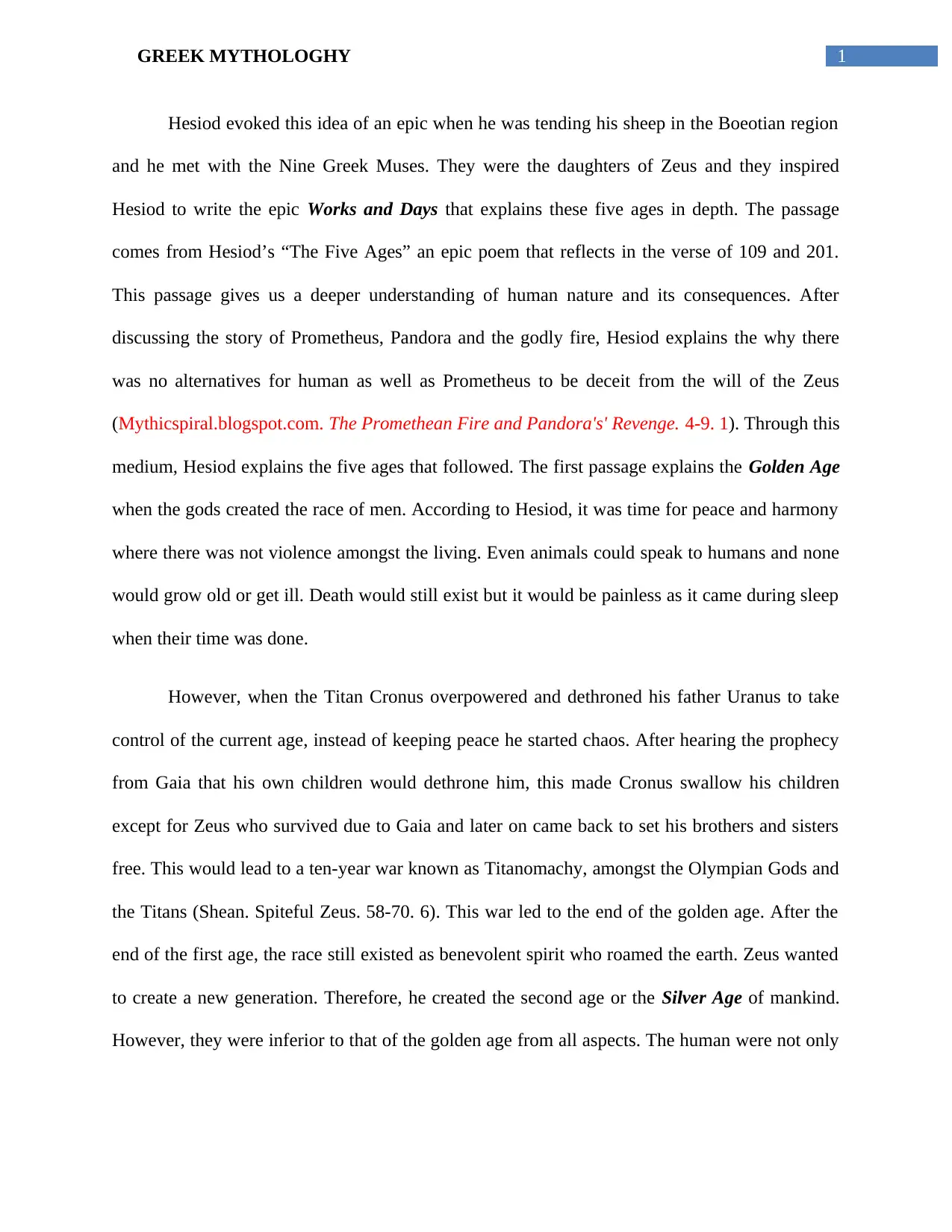
1GREEK MYTHOLOGHY
Hesiod evoked this idea of an epic when he was tending his sheep in the Boeotian region
and he met with the Nine Greek Muses. They were the daughters of Zeus and they inspired
Hesiod to write the epic Works and Days that explains these five ages in depth. The passage
comes from Hesiod’s “The Five Ages” an epic poem that reflects in the verse of 109 and 201.
This passage gives us a deeper understanding of human nature and its consequences. After
discussing the story of Prometheus, Pandora and the godly fire, Hesiod explains the why there
was no alternatives for human as well as Prometheus to be deceit from the will of the Zeus
(Mythicspiral.blogspot.com. The Promethean Fire and Pandora's' Revenge. 4-9. 1). Through this
medium, Hesiod explains the five ages that followed. The first passage explains the Golden Age
when the gods created the race of men. According to Hesiod, it was time for peace and harmony
where there was not violence amongst the living. Even animals could speak to humans and none
would grow old or get ill. Death would still exist but it would be painless as it came during sleep
when their time was done.
However, when the Titan Cronus overpowered and dethroned his father Uranus to take
control of the current age, instead of keeping peace he started chaos. After hearing the prophecy
from Gaia that his own children would dethrone him, this made Cronus swallow his children
except for Zeus who survived due to Gaia and later on came back to set his brothers and sisters
free. This would lead to a ten-year war known as Titanomachy, amongst the Olympian Gods and
the Titans (Shean. Spiteful Zeus. 58-70. 6). This war led to the end of the golden age. After the
end of the first age, the race still existed as benevolent spirit who roamed the earth. Zeus wanted
to create a new generation. Therefore, he created the second age or the Silver Age of mankind.
However, they were inferior to that of the golden age from all aspects. The human were not only
Hesiod evoked this idea of an epic when he was tending his sheep in the Boeotian region
and he met with the Nine Greek Muses. They were the daughters of Zeus and they inspired
Hesiod to write the epic Works and Days that explains these five ages in depth. The passage
comes from Hesiod’s “The Five Ages” an epic poem that reflects in the verse of 109 and 201.
This passage gives us a deeper understanding of human nature and its consequences. After
discussing the story of Prometheus, Pandora and the godly fire, Hesiod explains the why there
was no alternatives for human as well as Prometheus to be deceit from the will of the Zeus
(Mythicspiral.blogspot.com. The Promethean Fire and Pandora's' Revenge. 4-9. 1). Through this
medium, Hesiod explains the five ages that followed. The first passage explains the Golden Age
when the gods created the race of men. According to Hesiod, it was time for peace and harmony
where there was not violence amongst the living. Even animals could speak to humans and none
would grow old or get ill. Death would still exist but it would be painless as it came during sleep
when their time was done.
However, when the Titan Cronus overpowered and dethroned his father Uranus to take
control of the current age, instead of keeping peace he started chaos. After hearing the prophecy
from Gaia that his own children would dethrone him, this made Cronus swallow his children
except for Zeus who survived due to Gaia and later on came back to set his brothers and sisters
free. This would lead to a ten-year war known as Titanomachy, amongst the Olympian Gods and
the Titans (Shean. Spiteful Zeus. 58-70. 6). This war led to the end of the golden age. After the
end of the first age, the race still existed as benevolent spirit who roamed the earth. Zeus wanted
to create a new generation. Therefore, he created the second age or the Silver Age of mankind.
However, they were inferior to that of the golden age from all aspects. The human were not only
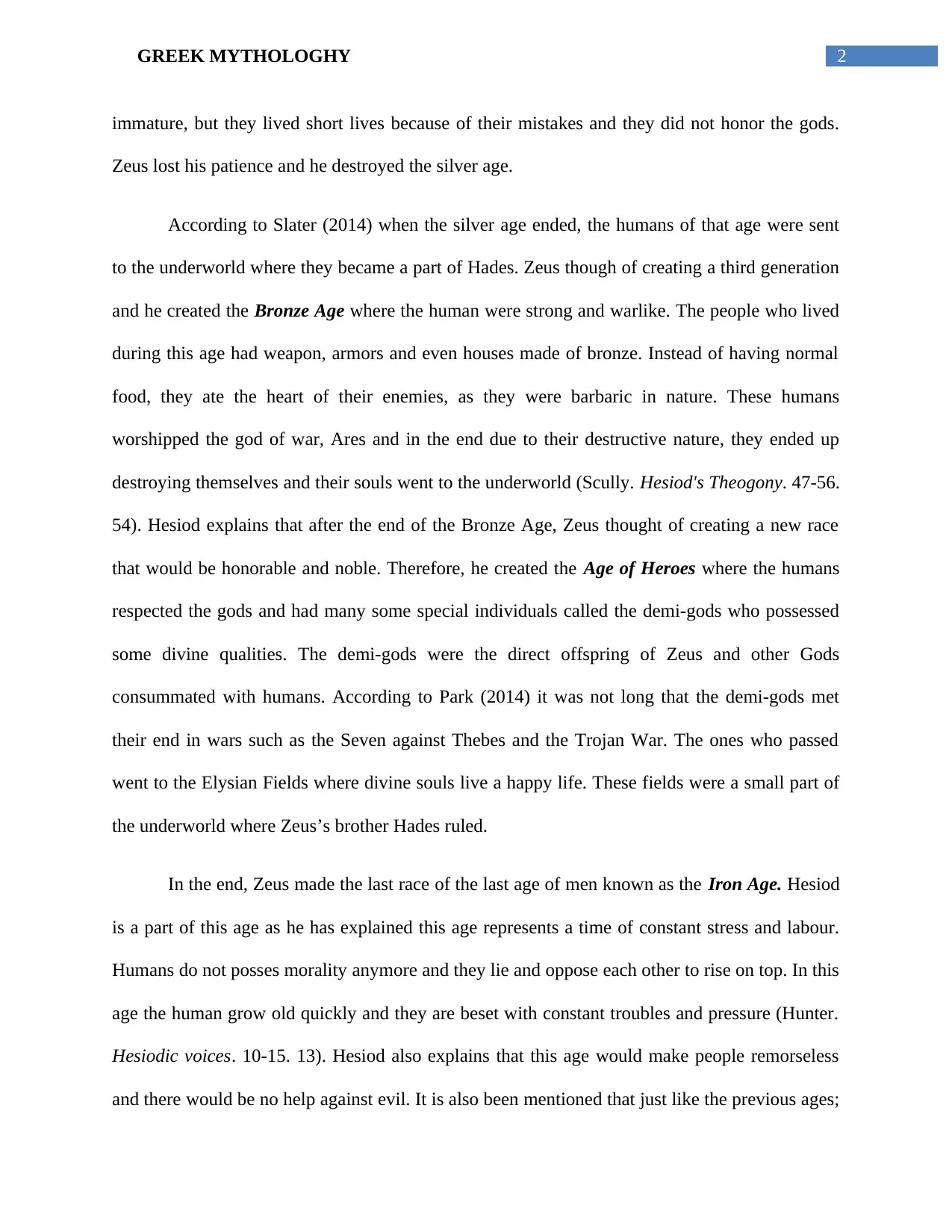
2GREEK MYTHOLOGHY
immature, but they lived short lives because of their mistakes and they did not honor the gods.
Zeus lost his patience and he destroyed the silver age.
According to Slater (2014) when the silver age ended, the humans of that age were sent
to the underworld where they became a part of Hades. Zeus though of creating a third generation
and he created the Bronze Age where the human were strong and warlike. The people who lived
during this age had weapon, armors and even houses made of bronze. Instead of having normal
food, they ate the heart of their enemies, as they were barbaric in nature. These humans
worshipped the god of war, Ares and in the end due to their destructive nature, they ended up
destroying themselves and their souls went to the underworld (Scully. Hesiod's Theogony. 47-56.
54). Hesiod explains that after the end of the Bronze Age, Zeus thought of creating a new race
that would be honorable and noble. Therefore, he created the Age of Heroes where the humans
respected the gods and had many some special individuals called the demi-gods who possessed
some divine qualities. The demi-gods were the direct offspring of Zeus and other Gods
consummated with humans. According to Park (2014) it was not long that the demi-gods met
their end in wars such as the Seven against Thebes and the Trojan War. The ones who passed
went to the Elysian Fields where divine souls live a happy life. These fields were a small part of
the underworld where Zeus’s brother Hades ruled.
In the end, Zeus made the last race of the last age of men known as the Iron Age. Hesiod
is a part of this age as he has explained this age represents a time of constant stress and labour.
Humans do not posses morality anymore and they lie and oppose each other to rise on top. In this
age the human grow old quickly and they are beset with constant troubles and pressure (Hunter.
Hesiodic voices. 10-15. 13). Hesiod also explains that this age would make people remorseless
and there would be no help against evil. It is also been mentioned that just like the previous ages;
immature, but they lived short lives because of their mistakes and they did not honor the gods.
Zeus lost his patience and he destroyed the silver age.
According to Slater (2014) when the silver age ended, the humans of that age were sent
to the underworld where they became a part of Hades. Zeus though of creating a third generation
and he created the Bronze Age where the human were strong and warlike. The people who lived
during this age had weapon, armors and even houses made of bronze. Instead of having normal
food, they ate the heart of their enemies, as they were barbaric in nature. These humans
worshipped the god of war, Ares and in the end due to their destructive nature, they ended up
destroying themselves and their souls went to the underworld (Scully. Hesiod's Theogony. 47-56.
54). Hesiod explains that after the end of the Bronze Age, Zeus thought of creating a new race
that would be honorable and noble. Therefore, he created the Age of Heroes where the humans
respected the gods and had many some special individuals called the demi-gods who possessed
some divine qualities. The demi-gods were the direct offspring of Zeus and other Gods
consummated with humans. According to Park (2014) it was not long that the demi-gods met
their end in wars such as the Seven against Thebes and the Trojan War. The ones who passed
went to the Elysian Fields where divine souls live a happy life. These fields were a small part of
the underworld where Zeus’s brother Hades ruled.
In the end, Zeus made the last race of the last age of men known as the Iron Age. Hesiod
is a part of this age as he has explained this age represents a time of constant stress and labour.
Humans do not posses morality anymore and they lie and oppose each other to rise on top. In this
age the human grow old quickly and they are beset with constant troubles and pressure (Hunter.
Hesiodic voices. 10-15. 13). Hesiod also explains that this age would make people remorseless
and there would be no help against evil. It is also been mentioned that just like the previous ages;
⊘ This is a preview!⊘
Do you want full access?
Subscribe today to unlock all pages.

Trusted by 1+ million students worldwide
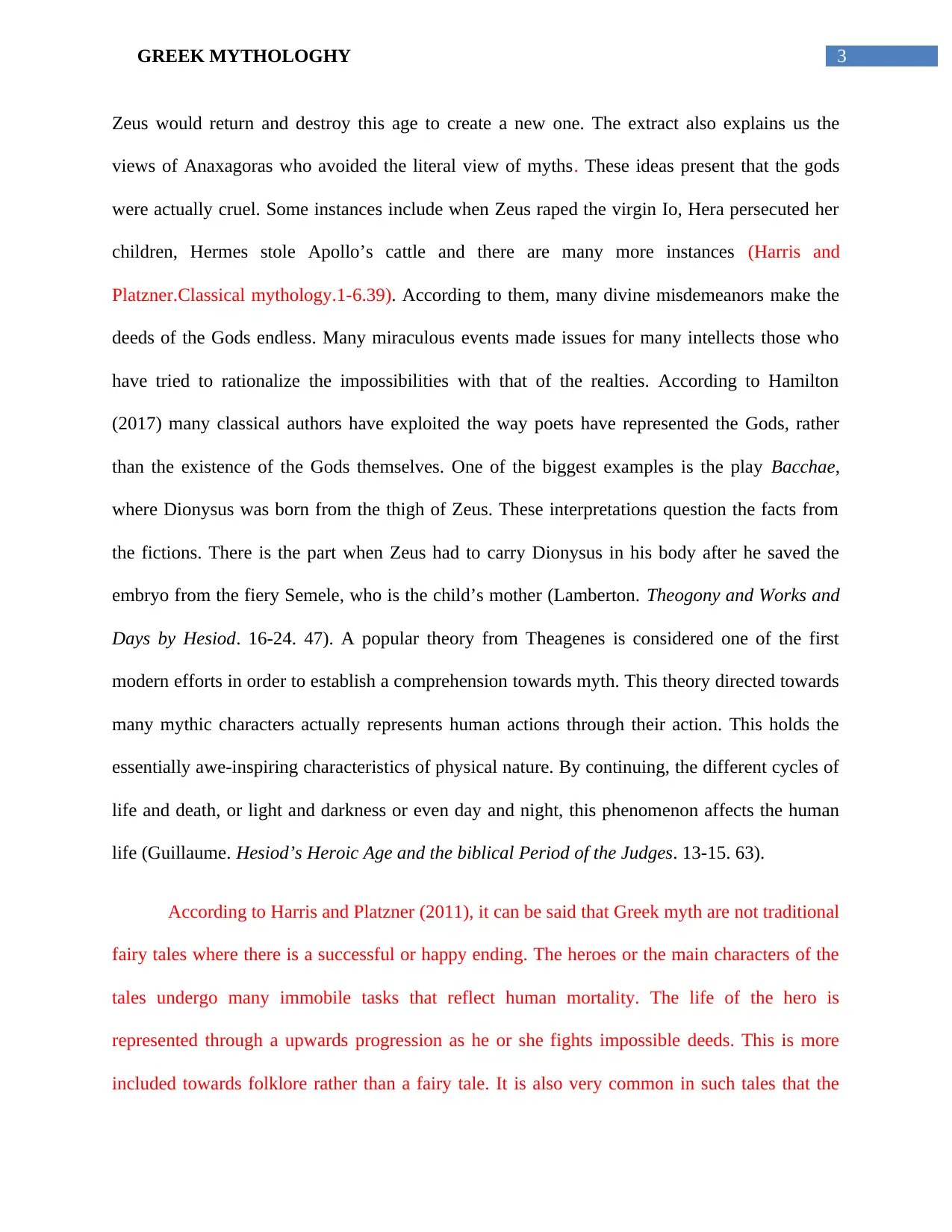
3GREEK MYTHOLOGHY
Zeus would return and destroy this age to create a new one. The extract also explains us the
views of Anaxagoras who avoided the literal view of myths. These ideas present that the gods
were actually cruel. Some instances include when Zeus raped the virgin Io, Hera persecuted her
children, Hermes stole Apollo’s cattle and there are many more instances (Harris and
Platzner.Classical mythology.1-6.39). According to them, many divine misdemeanors make the
deeds of the Gods endless. Many miraculous events made issues for many intellects those who
have tried to rationalize the impossibilities with that of the realties. According to Hamilton
(2017) many classical authors have exploited the way poets have represented the Gods, rather
than the existence of the Gods themselves. One of the biggest examples is the play Bacchae,
where Dionysus was born from the thigh of Zeus. These interpretations question the facts from
the fictions. There is the part when Zeus had to carry Dionysus in his body after he saved the
embryo from the fiery Semele, who is the child’s mother (Lamberton. Theogony and Works and
Days by Hesiod. 16-24. 47). A popular theory from Theagenes is considered one of the first
modern efforts in order to establish a comprehension towards myth. This theory directed towards
many mythic characters actually represents human actions through their action. This holds the
essentially awe-inspiring characteristics of physical nature. By continuing, the different cycles of
life and death, or light and darkness or even day and night, this phenomenon affects the human
life (Guillaume. Hesiod’s Heroic Age and the biblical Period of the Judges. 13-15. 63).
According to Harris and Platzner (2011), it can be said that Greek myth are not traditional
fairy tales where there is a successful or happy ending. The heroes or the main characters of the
tales undergo many immobile tasks that reflect human mortality. The life of the hero is
represented through a upwards progression as he or she fights impossible deeds. This is more
included towards folklore rather than a fairy tale. It is also very common in such tales that the
Zeus would return and destroy this age to create a new one. The extract also explains us the
views of Anaxagoras who avoided the literal view of myths. These ideas present that the gods
were actually cruel. Some instances include when Zeus raped the virgin Io, Hera persecuted her
children, Hermes stole Apollo’s cattle and there are many more instances (Harris and
Platzner.Classical mythology.1-6.39). According to them, many divine misdemeanors make the
deeds of the Gods endless. Many miraculous events made issues for many intellects those who
have tried to rationalize the impossibilities with that of the realties. According to Hamilton
(2017) many classical authors have exploited the way poets have represented the Gods, rather
than the existence of the Gods themselves. One of the biggest examples is the play Bacchae,
where Dionysus was born from the thigh of Zeus. These interpretations question the facts from
the fictions. There is the part when Zeus had to carry Dionysus in his body after he saved the
embryo from the fiery Semele, who is the child’s mother (Lamberton. Theogony and Works and
Days by Hesiod. 16-24. 47). A popular theory from Theagenes is considered one of the first
modern efforts in order to establish a comprehension towards myth. This theory directed towards
many mythic characters actually represents human actions through their action. This holds the
essentially awe-inspiring characteristics of physical nature. By continuing, the different cycles of
life and death, or light and darkness or even day and night, this phenomenon affects the human
life (Guillaume. Hesiod’s Heroic Age and the biblical Period of the Judges. 13-15. 63).
According to Harris and Platzner (2011), it can be said that Greek myth are not traditional
fairy tales where there is a successful or happy ending. The heroes or the main characters of the
tales undergo many immobile tasks that reflect human mortality. The life of the hero is
represented through a upwards progression as he or she fights impossible deeds. This is more
included towards folklore rather than a fairy tale. It is also very common in such tales that the
Paraphrase This Document
Need a fresh take? Get an instant paraphrase of this document with our AI Paraphraser
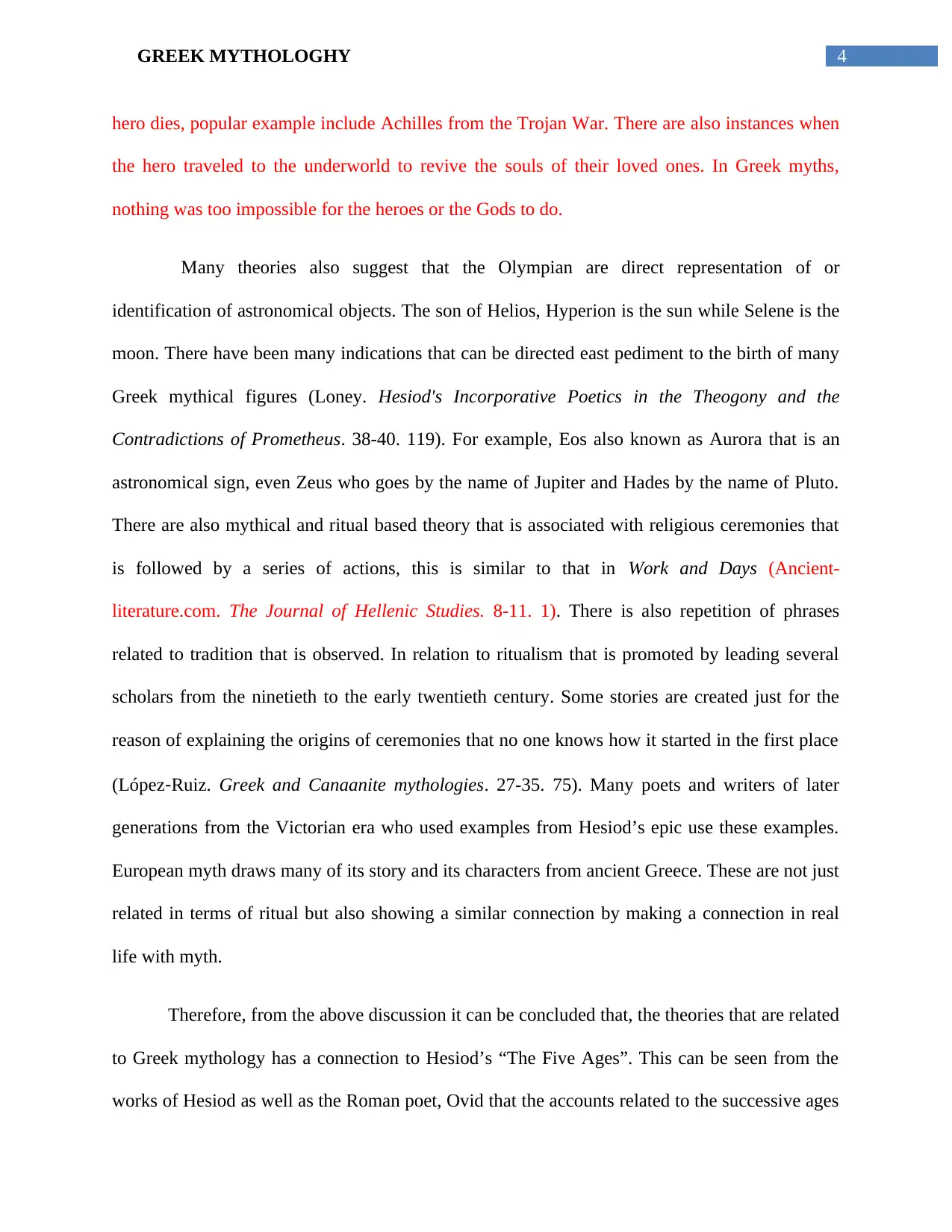
4GREEK MYTHOLOGHY
hero dies, popular example include Achilles from the Trojan War. There are also instances when
the hero traveled to the underworld to revive the souls of their loved ones. In Greek myths,
nothing was too impossible for the heroes or the Gods to do.
Many theories also suggest that the Olympian are direct representation of or
identification of astronomical objects. The son of Helios, Hyperion is the sun while Selene is the
moon. There have been many indications that can be directed east pediment to the birth of many
Greek mythical figures (Loney. Hesiod's Incorporative Poetics in the Theogony and the
Contradictions of Prometheus. 38-40. 119). For example, Eos also known as Aurora that is an
astronomical sign, even Zeus who goes by the name of Jupiter and Hades by the name of Pluto.
There are also mythical and ritual based theory that is associated with religious ceremonies that
is followed by a series of actions, this is similar to that in Work and Days (Ancient-
literature.com. The Journal of Hellenic Studies. 8-11. 1). There is also repetition of phrases
related to tradition that is observed. In relation to ritualism that is promoted by leading several
scholars from the ninetieth to the early twentieth century. Some stories are created just for the
reason of explaining the origins of ceremonies that no one knows how it started in the first place
(López‐Ruiz. Greek and Canaanite mythologies. 27-35. 75). Many poets and writers of later
generations from the Victorian era who used examples from Hesiod’s epic use these examples.
European myth draws many of its story and its characters from ancient Greece. These are not just
related in terms of ritual but also showing a similar connection by making a connection in real
life with myth.
Therefore, from the above discussion it can be concluded that, the theories that are related
to Greek mythology has a connection to Hesiod’s “The Five Ages”. This can be seen from the
works of Hesiod as well as the Roman poet, Ovid that the accounts related to the successive ages
hero dies, popular example include Achilles from the Trojan War. There are also instances when
the hero traveled to the underworld to revive the souls of their loved ones. In Greek myths,
nothing was too impossible for the heroes or the Gods to do.
Many theories also suggest that the Olympian are direct representation of or
identification of astronomical objects. The son of Helios, Hyperion is the sun while Selene is the
moon. There have been many indications that can be directed east pediment to the birth of many
Greek mythical figures (Loney. Hesiod's Incorporative Poetics in the Theogony and the
Contradictions of Prometheus. 38-40. 119). For example, Eos also known as Aurora that is an
astronomical sign, even Zeus who goes by the name of Jupiter and Hades by the name of Pluto.
There are also mythical and ritual based theory that is associated with religious ceremonies that
is followed by a series of actions, this is similar to that in Work and Days (Ancient-
literature.com. The Journal of Hellenic Studies. 8-11. 1). There is also repetition of phrases
related to tradition that is observed. In relation to ritualism that is promoted by leading several
scholars from the ninetieth to the early twentieth century. Some stories are created just for the
reason of explaining the origins of ceremonies that no one knows how it started in the first place
(López‐Ruiz. Greek and Canaanite mythologies. 27-35. 75). Many poets and writers of later
generations from the Victorian era who used examples from Hesiod’s epic use these examples.
European myth draws many of its story and its characters from ancient Greece. These are not just
related in terms of ritual but also showing a similar connection by making a connection in real
life with myth.
Therefore, from the above discussion it can be concluded that, the theories that are related
to Greek mythology has a connection to Hesiod’s “The Five Ages”. This can be seen from the
works of Hesiod as well as the Roman poet, Ovid that the accounts related to the successive ages
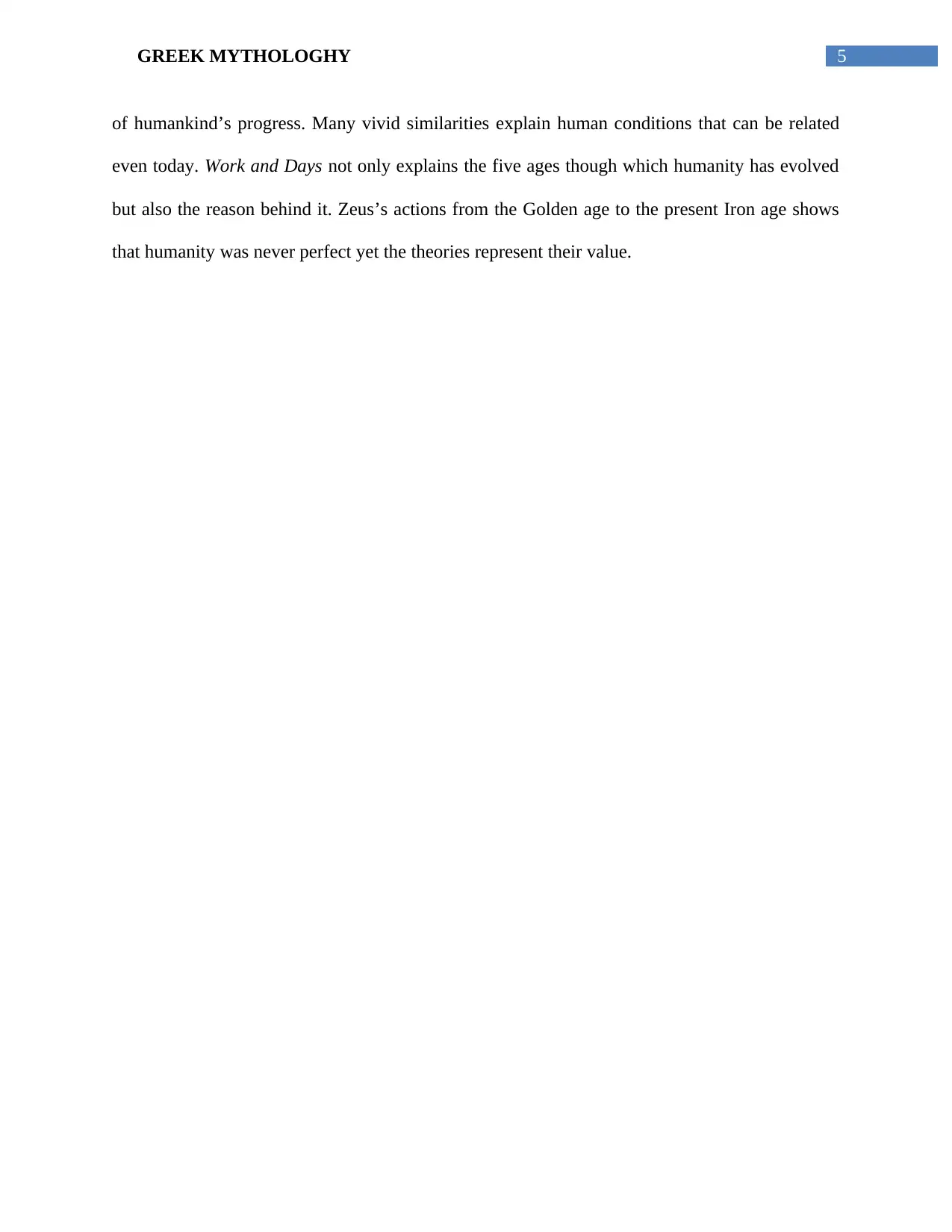
5GREEK MYTHOLOGHY
of humankind’s progress. Many vivid similarities explain human conditions that can be related
even today. Work and Days not only explains the five ages though which humanity has evolved
but also the reason behind it. Zeus’s actions from the Golden age to the present Iron age shows
that humanity was never perfect yet the theories represent their value.
of humankind’s progress. Many vivid similarities explain human conditions that can be related
even today. Work and Days not only explains the five ages though which humanity has evolved
but also the reason behind it. Zeus’s actions from the Golden age to the present Iron age shows
that humanity was never perfect yet the theories represent their value.
⊘ This is a preview!⊘
Do you want full access?
Subscribe today to unlock all pages.

Trusted by 1+ million students worldwide
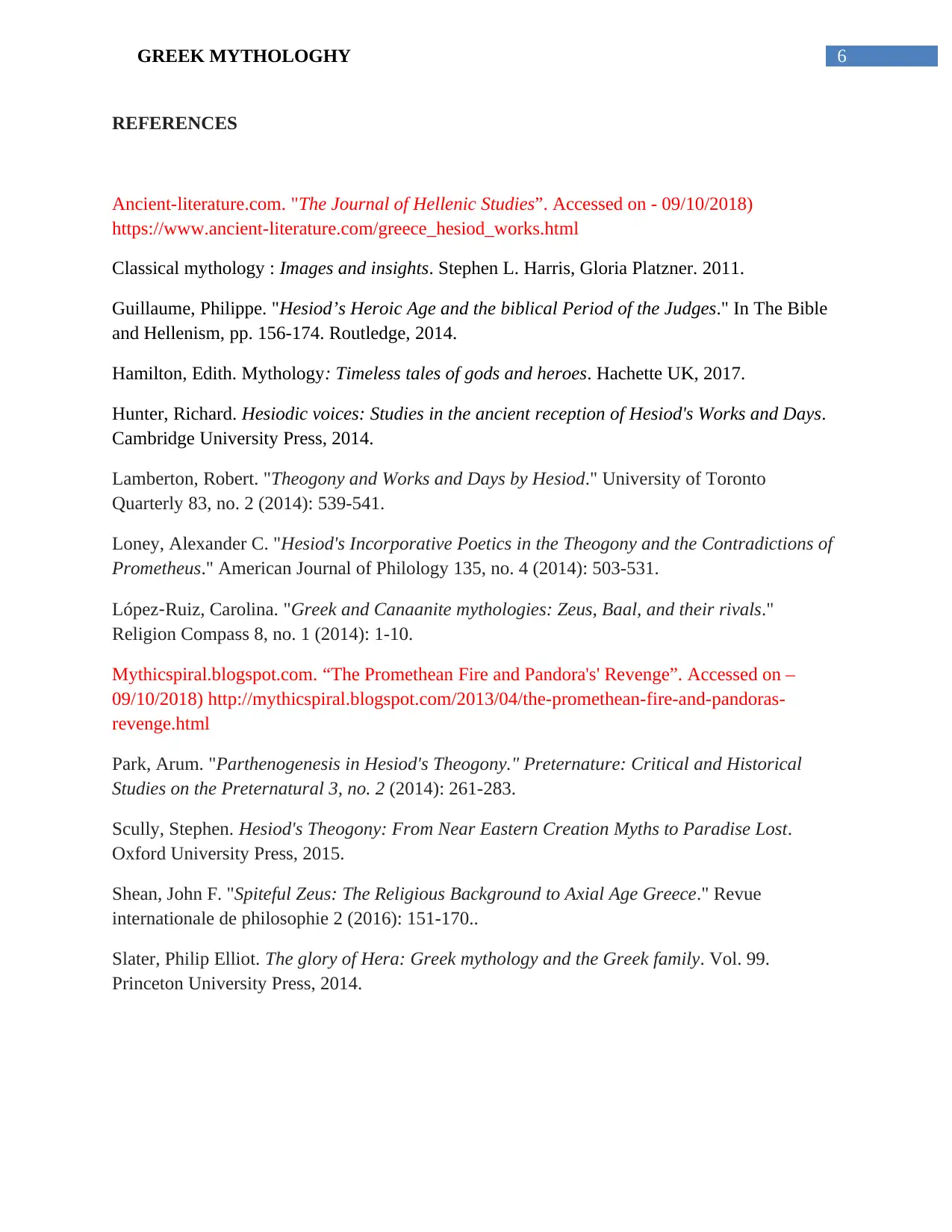
6GREEK MYTHOLOGHY
REFERENCES
Ancient-literature.com. "The Journal of Hellenic Studies”. Accessed on - 09/10/2018)
https://www.ancient-literature.com/greece_hesiod_works.html
Classical mythology : Images and insights. Stephen L. Harris, Gloria Platzner. 2011.
Guillaume, Philippe. "Hesiod’s Heroic Age and the biblical Period of the Judges." In The Bible
and Hellenism, pp. 156-174. Routledge, 2014.
Hamilton, Edith. Mythology: Timeless tales of gods and heroes. Hachette UK, 2017.
Hunter, Richard. Hesiodic voices: Studies in the ancient reception of Hesiod's Works and Days.
Cambridge University Press, 2014.
Lamberton, Robert. "Theogony and Works and Days by Hesiod." University of Toronto
Quarterly 83, no. 2 (2014): 539-541.
Loney, Alexander C. "Hesiod's Incorporative Poetics in the Theogony and the Contradictions of
Prometheus." American Journal of Philology 135, no. 4 (2014): 503-531.
López‐Ruiz, Carolina. "Greek and Canaanite mythologies: Zeus, Baal, and their rivals."
Religion Compass 8, no. 1 (2014): 1-10.
Mythicspiral.blogspot.com. “The Promethean Fire and Pandora's' Revenge”. Accessed on –
09/10/2018) http://mythicspiral.blogspot.com/2013/04/the-promethean-fire-and-pandoras-
revenge.html
Park, Arum. "Parthenogenesis in Hesiod's Theogony." Preternature: Critical and Historical
Studies on the Preternatural 3, no. 2 (2014): 261-283.
Scully, Stephen. Hesiod's Theogony: From Near Eastern Creation Myths to Paradise Lost.
Oxford University Press, 2015.
Shean, John F. "Spiteful Zeus: The Religious Background to Axial Age Greece." Revue
internationale de philosophie 2 (2016): 151-170..
Slater, Philip Elliot. The glory of Hera: Greek mythology and the Greek family. Vol. 99.
Princeton University Press, 2014.
REFERENCES
Ancient-literature.com. "The Journal of Hellenic Studies”. Accessed on - 09/10/2018)
https://www.ancient-literature.com/greece_hesiod_works.html
Classical mythology : Images and insights. Stephen L. Harris, Gloria Platzner. 2011.
Guillaume, Philippe. "Hesiod’s Heroic Age and the biblical Period of the Judges." In The Bible
and Hellenism, pp. 156-174. Routledge, 2014.
Hamilton, Edith. Mythology: Timeless tales of gods and heroes. Hachette UK, 2017.
Hunter, Richard. Hesiodic voices: Studies in the ancient reception of Hesiod's Works and Days.
Cambridge University Press, 2014.
Lamberton, Robert. "Theogony and Works and Days by Hesiod." University of Toronto
Quarterly 83, no. 2 (2014): 539-541.
Loney, Alexander C. "Hesiod's Incorporative Poetics in the Theogony and the Contradictions of
Prometheus." American Journal of Philology 135, no. 4 (2014): 503-531.
López‐Ruiz, Carolina. "Greek and Canaanite mythologies: Zeus, Baal, and their rivals."
Religion Compass 8, no. 1 (2014): 1-10.
Mythicspiral.blogspot.com. “The Promethean Fire and Pandora's' Revenge”. Accessed on –
09/10/2018) http://mythicspiral.blogspot.com/2013/04/the-promethean-fire-and-pandoras-
revenge.html
Park, Arum. "Parthenogenesis in Hesiod's Theogony." Preternature: Critical and Historical
Studies on the Preternatural 3, no. 2 (2014): 261-283.
Scully, Stephen. Hesiod's Theogony: From Near Eastern Creation Myths to Paradise Lost.
Oxford University Press, 2015.
Shean, John F. "Spiteful Zeus: The Religious Background to Axial Age Greece." Revue
internationale de philosophie 2 (2016): 151-170..
Slater, Philip Elliot. The glory of Hera: Greek mythology and the Greek family. Vol. 99.
Princeton University Press, 2014.
Paraphrase This Document
Need a fresh take? Get an instant paraphrase of this document with our AI Paraphraser

7GREEK MYTHOLOGHY
1 out of 8
Your All-in-One AI-Powered Toolkit for Academic Success.
+13062052269
info@desklib.com
Available 24*7 on WhatsApp / Email
![[object Object]](/_next/static/media/star-bottom.7253800d.svg)
Unlock your academic potential
Copyright © 2020–2025 A2Z Services. All Rights Reserved. Developed and managed by ZUCOL.
